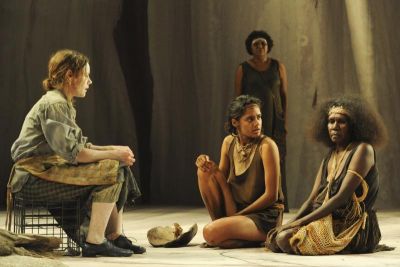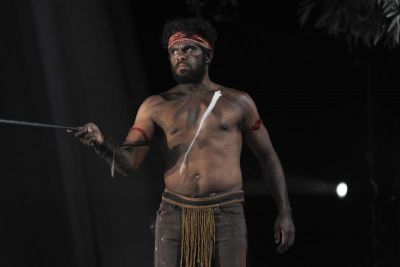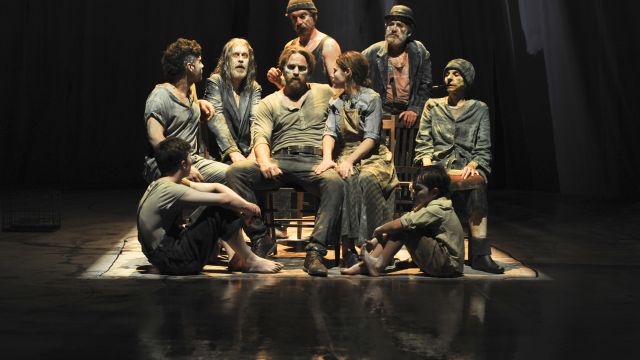The Secret River
There are times a quasi-theatre geek becomes aware of the circulation-restricting pleb pants they wear as they sit poised to review something that cannot be simply summed up with generic praise. It's daunting enough that this is a 'return' season of a benchmark production which achieved justifiably passionate reviews three years ago. It's a two-fold dilemma: what can be said that hasn't been said before? And how do you describe something that really needs to be experienced to be fully appreciated?
The story represents a typical scenario from the early days of Australian settlement. William Thornhill, a newly-pardoned convict, helps himself to a prime parcel of land on the banks of the Hawkesbury River. Soon he and his young family encounter this property's rightful owners - a family of Dharug people. The obnoxious sense of entitlement with which Thornhill seizes this land from the locals is portrayed in the kind of sympathetic light with which we are used to bathing that 'pioneering spirit'. The ease with which the younger of his two sons befriends the native children adds to this initial theme of innocence.
 Enter two neighbouring settlers/squatters; each have established starkly contrasting relationships with the original inhabitants: one is harmonious and the other, sickeningly cruel and inhumane. Both men seem perched on Thornhill's shoulders like the quintessential angel and devil, begging the question: which neighbour will influence his decisions on how to deal with resistance from the natives?
Enter two neighbouring settlers/squatters; each have established starkly contrasting relationships with the original inhabitants: one is harmonious and the other, sickeningly cruel and inhumane. Both men seem perched on Thornhill's shoulders like the quintessential angel and devil, begging the question: which neighbour will influence his decisions on how to deal with resistance from the natives?
Up until around 20 years ago, most dramatic representations of Australian heritage revolved around the survival stories of our 'heroic' convict settlers; those scrappy unionists and the tragic events of World War I. The resistance from some quarters, to Reconciliation and reparation has been directly influenced by this somewhat romantic version of history. The confronting nature of lesser-known stories regarding the darker side of our history, which have been hitherto suppressed, have been hard to hear.
Imagine then, how much harder they are to tell.
 The most powerful take-away from this production was the objective perspective it presented. Thornhill's actions, while not excusable are presented as inexorable from his distorted viewpoint; thus compounding the overall sense of tragedy at a basic human level. The feeling of “connectedness” that permeates every aspect of this production somehow provides an eerie sense of redemption. From the evocative, imposing and beautifully-lit backdrop, to the warmly unobtrusive yet integral soundscape and musical interludes - to the convincing familial relationships portrayed by the leads and the species-transcending mutability of the entire ensemble. To attempt to list the aesthetic nuances and allegorical devices that enhanced the cinematic quality of the narrative, is quite frankly beyond me (I possibly missed a lot too); but clumsy, muddy footprints and subsequent drawings made on the raked stage spoke volumes for a start. This was 'our' story. There was so much to take in with this production that it begs repeated viewings. The denouement is undoubtedly gut-wrenching, but the sense of tragedy belongs to both sides. The instantaneous standing ovation on opening night, for three bows (in Sydney!) felt very healing and palpably uniting.
The most powerful take-away from this production was the objective perspective it presented. Thornhill's actions, while not excusable are presented as inexorable from his distorted viewpoint; thus compounding the overall sense of tragedy at a basic human level. The feeling of “connectedness” that permeates every aspect of this production somehow provides an eerie sense of redemption. From the evocative, imposing and beautifully-lit backdrop, to the warmly unobtrusive yet integral soundscape and musical interludes - to the convincing familial relationships portrayed by the leads and the species-transcending mutability of the entire ensemble. To attempt to list the aesthetic nuances and allegorical devices that enhanced the cinematic quality of the narrative, is quite frankly beyond me (I possibly missed a lot too); but clumsy, muddy footprints and subsequent drawings made on the raked stage spoke volumes for a start. This was 'our' story. There was so much to take in with this production that it begs repeated viewings. The denouement is undoubtedly gut-wrenching, but the sense of tragedy belongs to both sides. The instantaneous standing ovation on opening night, for three bows (in Sydney!) felt very healing and palpably uniting.
Rose Cooper
Photographer: Heidrun Löhr
Subscribe to our E-Newsletter, buy our latest print edition or find a Performing Arts book at Book Nook.

